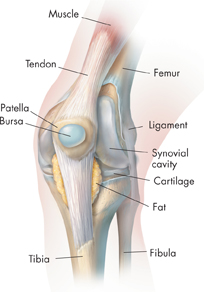Structure of Joints In freely movable joints, cartilage covers the surfaces where two bones come together. This protects the bones from damage as they move against each other. The joints are also surrounded by a fibrous joint capsule that helps hold the bones together while still allowing for movement.
The joint capsule consists of two layers. The outer layer forms strips of tough connective tissue called ligaments. Ligaments, which hold bones together in a joint, are attached to the membranes that surround bones. The inner layer of the joint capsule, called the synovial (sih NOH vee uhl) cavity, contains cells that produce a substance called synovial fluid. Synovial fluid enables the surfaces of the bones connected at the joint to slide over each other smoothly.
In some freely movable joints, such as the knee shown in Figure 32–4, there are small sacs of synovial fluid called bursae (BUR see; singular: bursa). Bursae reduce the friction between the bones of a joint and any tissues they come in contact with. Bursae also act as tiny shock absorbers.

FIGURE 32–4 The Knee The knee joint is protected by cartilage and bursae. Ligaments hold together the four bones that make up the knee joint—the femur, patella, tibia, and fibula. Infer How do cartilage and bursae help reduce friction?
ddJoint Injuries A common injury among young athletes is damage to the anterior cruciate ligament (ACL). This ligament is found in the center of the knee between the femur and tibia. It prevents the tibia from shifting too far forward during movement. ACL damage can be caused by the rapid pivoting, leaping, and forceful contacts that occur when playing sports like basketball and soccer. If the ACL is damaged, the knee becomes unstable and prone to other injuries.
Excessive strain on a joint may produce inflammation, a response in which excess fluid causes swelling, pain, heat, and redness. Inflammation of a bursa is called bursitis.
Wear and tear over the years often leads to osteoarthritis. This disorder develops as the cartilage of often used joints in the fingers, knees, hips, and spine begins to break down. The affected joints become painful and stiff as unprotected bones start to rub together.
32.1 Assessment

-
Review List the different functions of the skeletal system.
Predict If blood calcium levels in a person's body were consistently low due to poor diet, what could the effect be on the person's bones?
-
Review Describe the structure of a typical bone.
Infer Why do you think the amount of cartilage decreases and the amount of bone increases as a baby grows?
-
Review What is a joint?
Use Analogies Which type of freely movable joint would you compare to a doorknob? Explain.
WRITE ABOUT SCIENCE
Use library or Internet resources to learn more about osteoporosis. Then, develop an advertising campaign for the dairy industry based on the relationship between calcium and healthy bone development and maintenance.

Table of Contents
- Formulas and Equations
- Applying Formulas and Equations
- Mean, Median, and Mode
- Estimation
- Using Measurements in Calculations
- Effects of Measurement Errors
- Accuracy
- Precision
- Comparing Accuracy and Precision
- Significant Figures
- Calculating With Significant Figures
- Scientific Notation
- Calculating With Scientific Notation
- Dimensional Analysis
- Applying Dimensional Analysis




